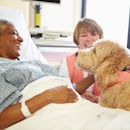
Pet Therapy
Pet Encounter Therapy (Pet), also known as animal-assisted therapy, is a holistic strategy for patient treatment and disease management. Even Florence Nightingale noted the benefits of pet companions to the infirmed patient (Nightingale, 1946). Although other animals are used, dogs are the most common animal that provides pet therapy.
Pet therapy provides distraction and therapeutic touch, which has been shown to reduce blood pressure, heart rate, and feelings of stress. Benefits have been demonstrated in studies for improving emotional, cognitive, social, and physical functioning. Multiple studies have been done which show the improvements that occur by using pet therapy strategies. These include improving self-care, and cognition, and cultivating social skills in patients with mental illness and dementia (Koukourikos et al., 2019). Other studies show that there is an improvement in pain management, and is assistive when performing procedures on patients in pediatric and adult populations (McCullough, Ruehrdanz, & Jenkins, 2016).
Confirmation that pet therapy is beneficial across age groups can be seen when considering a 2019 study by Hinic, Kowalski, and Holtzman which concluded that “pet therapy is an effective complementary therapy to decrease anxiety in a hospitalized child”. Likewise, a 2010 study on pet therapy and elderly patients with mental illness found that pet therapy is efficient in improving depressive symptoms and cognitive function in residents of long‐term care facilities with mental illness (Moretti, et al., 2010). Pet therapy also has benefits for families and staff members (Becze, 2018).
One of the concerns in hospital pet therapy programs in infection prevention and risk management. Effective policies and procedures to provide a structured pet therapy program can ensure success. Animals used in pet therapy programs should be well-trained, healthy with veterinary assurances, and clean. Pet handlers also require training for hospital policies and procedures, including infection prevention and confidentiality requirements. Good hand hygiene practices are reinforced following the touch of animals (McCullough, Ruehrdanz, & Jenkins, 2016). Nurses can help advocate for providing pet therapy in facilities where they work.
The idea of pet therapy is not new. Florence Nightingale, the mother of nursing, recognized its benefits in the 1800s. Studies have found that pet therapy is a beneficial strategy for disease management. Fortunately, infection prevention risks can be mitigated with adherence to policies and procedures.
References
Becze, E. (2018). Animal therapy has benefits for patients- and healthcare staff.
Hinic, K., Kowalskji, M., & Holtzman, K. (2019). The effect of PET therapy and comparison intervention n on anxiety in hospitalized children. Journal of Pediatric Nursing. doi:
Koukourikos, K., Georgopoulou, A., Kourkouta, L., & Tsaloglidou, A. (2019). Benefits of animal assisted therapy in mental health. International Journal of Caring Sciences, 12(3), 1898–1905.
McCullough, A., Ruehrdanz, A., Jenkins, M. (2016). The use of dogs in hospital settings. HABRI Central Briefs, 1-9.
Moretti, F., De Ronchi, D., Bernabei, V., Marchetti, L., Ferrari, B.,…Atti, A. (2010) Pet therapy in elderly patients with mental illness. Pyschogeriatrics. doi: Nightingale, F. (1946). Notes on nursing: What it is and what it is not. New York, NY: Appleton-Century.




